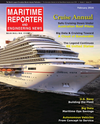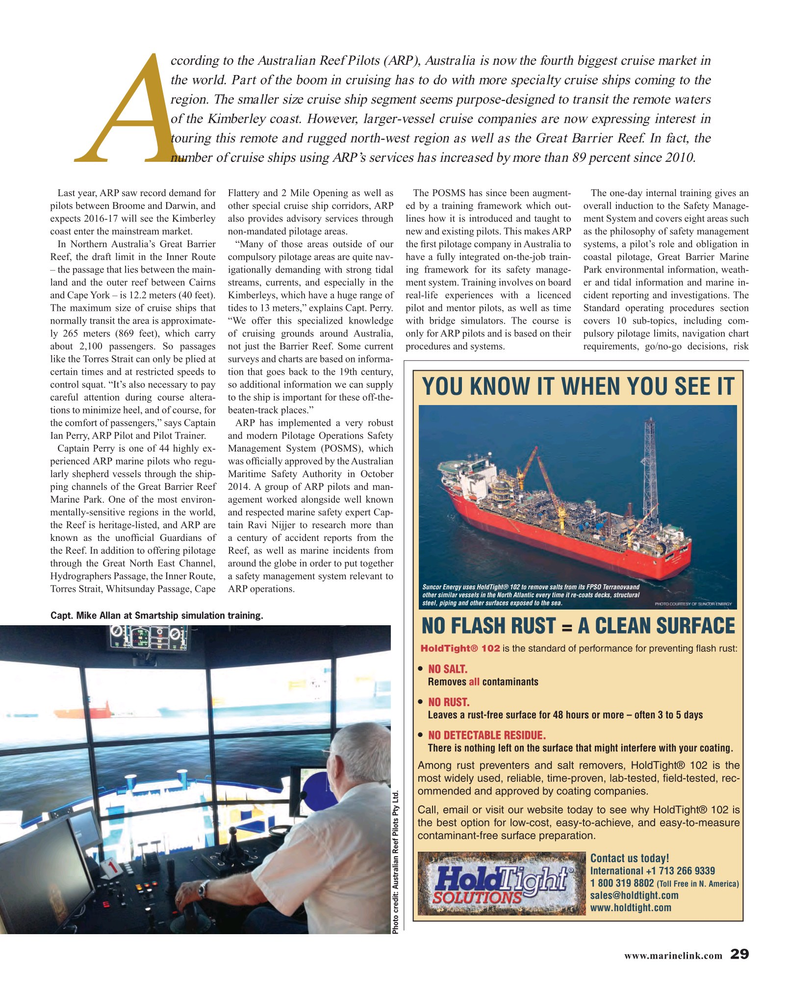
Page 29: of Maritime Reporter Magazine (February 2016)
Cruise Ship Technology Edition
Read this page in Pdf, Flash or Html5 edition of February 2016 Maritime Reporter Magazine
ccording to the Australian Reef Pilots (ARP), Australia is now the fourth biggest cruise market in the world. Part of the boom in cruising has to do with more specialty cruise ships coming to the region. The smaller size cruise ship segment seems purpose-designed to transit the remote waters of the Kimberley coast. However, larger-vessel cruise companies are now expressing interest in touring this remote and rugged north-west region as well as the Great Barrier Reef. In fact, the number of cruise ships using ARP’s services has increased by more than 89 percent since 2010.
A
Last year, ARP saw record demand for Flattery and 2 Mile Opening as well as The POSMS has since been augment- The one-day internal training gives an pilots between Broome and Darwin, and other special cruise ship corridors, ARP ed by a training framework which out- overall induction to the Safety Manage- expects 2016-17 will see the Kimberley also provides advisory services through lines how it is introduced and taught to ment System and covers eight areas such coast enter the mainstream market. non-mandated pilotage areas. new and existing pilots. This makes ARP as the philosophy of safety management
In Northern Australia’s Great Barrier “Many of those areas outside of our the ? rst pilotage company in Australia to systems, a pilot’s role and obligation in
Reef, the draft limit in the Inner Route compulsory pilotage areas are quite nav- have a fully integrated on-the-job train- coastal pilotage, Great Barrier Marine – the passage that lies between the main- igationally demanding with strong tidal ing framework for its safety manage- Park environmental information, weath- land and the outer reef between Cairns streams, currents, and especially in the ment system. Training involves on board er and tidal information and marine in- and Cape York – is 12.2 meters (40 feet). Kimberleys, which have a huge range of real-life experiences with a licenced cident reporting and investigations. The
The maximum size of cruise ships that tides to 13 meters,” explains Capt. Perry. pilot and mentor pilots, as well as time Standard operating procedures section normally transit the area is approximate- “We offer this specialized knowledge with bridge simulators. The course is covers 10 sub-topics, including com- ly 265 meters (869 feet), which carry of cruising grounds around Australia, only for ARP pilots and is based on their pulsory pilotage limits, navigation chart about 2,100 passengers. So passages not just the Barrier Reef. Some current procedures and systems. requirements, go/no-go decisions, risk like the Torres Strait can only be plied at surveys and charts are based on informa- certain times and at restricted speeds to tion that goes back to the 19th century, control squat. “It’s also necessary to pay so additional information we can supply
YOU KNOW IT WHEN YOU SEE IT careful attention during course altera- to the ship is important for these off-the- tions to minimize heel, and of course, for beaten-track places.” the comfort of passengers,” says Captain ARP has implemented a very robust
Ian Perry, ARP Pilot and Pilot Trainer. and modern Pilotage Operations Safety
Captain Perry is one of 44 highly ex- Management System (POSMS), which perienced ARP marine pilots who regu- was of? cially approved by the Australian larly shepherd vessels through the ship- Maritime Safety Authority in October ping channels of the Great Barrier Reef 2014. A group of ARP pilots and man-
Marine Park. One of the most environ- agement worked alongside well known mentally-sensitive regions in the world, and respected marine safety expert Cap- the Reef is heritage-listed, and ARP are tain Ravi Nijjer to research more than known as the unof? cial Guardians of a century of accident reports from the the Reef. In addition to offering pilotage Reef, as well as marine incidents from through the Great North East Channel, around the globe in order to put together
Hydrographers Passage, the Inner Route, a safety management system relevant to
Suncor Energy uses HoldTight® 102 to remove salts from its FPSO Terranovaand
Torres Strait, Whitsunday Passage, Cape ARP operations.
other similar vessels in the North Atlantic every time it re-coats decks, structural steel, piping and other surfaces exposed to the sea.
Capt. Mike Allan at Smartship simulation training.
NO FLASH RUST = A CLEAN SURFACE
HoldTight® 102 is the standard of performance for preventing ?ash rust: s NO SALT.
Removes all contaminants s NO RUST.
Leaves a rust-free surface for 48 hours or more – often 3 to 5 days s NO DETECTABLE RESIDUE.
There is nothing left on the surface that might interfere with your coating.
Among rust preventers and salt removers, HoldTight® 102 is the most widely used, reliable, time-proven, lab-tested, ?eld-tested, rec- ommended and approved by coating companies.
Call, email or visit our website today to see why HoldTight® 102 is the best option for low-cost, easy-to-achieve, and easy-to-measure contaminant-free surface preparation.
Contact us today!
International +1 713 266 9339 1 800 319 8802 (Toll Free in N. America) [email protected] www.holdtight.com
Photo credit: Australian Reef Pilots Pty Ltd.
www.marinelink.com 29
MR #2 (26-33).indd 29 2/3/2016 10:41:18 AM

 28
28

 30
30
